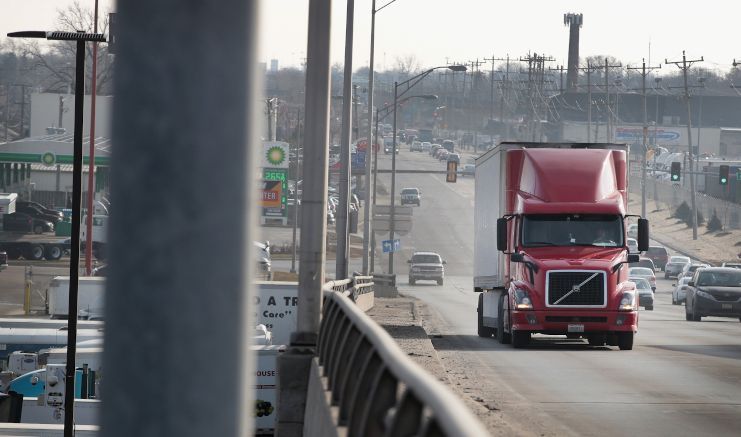A couple of days ago I asked my old friend Vladan, who taught me how to drive big rigs, about his thoughts on the so-called “truckers’ freedom convoy.” Vladan, who has been trucking long-distance for the last 25 years, answered with resignation in his voice. “What can I say? I waited at the Ambassador Bridge for four hours on my way to Texas, and another three hours on my way back.” Since Vladan is an owner-operator (he owns his truck but gets loads through an outside trucking company), he is paid by the mile and not by the hour. Therefore, the hours he spent waiting to cross the border represented nearly an entire day at work for which he simply didn’t get paid a red cent. “Those ‘protesters’ don’t have anything to do with trucking and couldn’t care less about truckers,” was Vladan’s conclusion.
In all the tumult of the past month, and with mainstream media’s fascination with the unprecedented far-right protest, and now the Russian war in Ukraine, most of the media and Canadian public seem to have forgotten about the large majority of truck drivers. So how are Canadian truckers doing? To answer this question, the trucking industry needs to be put in the context of the global restructuring of capitalism, which has been taking place since the mid-1970s in response to falling profits, rising wages, and increased labour militancy of the 1960s and early 1970s.
Neoliberalism and its consequences
As supply chains started to stretch across the face of the Earth in search of cheaper labour and higher profits, manufacturing increasingly became a global activity. At the same time, technological innovations in materials, computing, and telecommunication made possible “just-in-time” production systems. With this method of production, needed components are delivered to factories “just in time” to be used in the manufacturing process while the finished products are shipped to customers immediately after they are completed. However, what made these systems possible were not just technological and organizational changes. Ultimately, they were based on the elimination of any possibility of disruption of the seamless links between manufacturing and transportation. From the bosses’ point of view, therefore, what was needed was to deeply undermine the ability of unions to organize and especially, to strike for higher wages and better working conditions.
The first taste of what the North American capitalist class envisioned on this front was the Motor Carrier Act of 1980, which marked the beginning of deregulation of the trucking industry in the United States. Introduced by the Jimmy Carter administration, this act made it easier for new companies to enter the trucking industry at the same time as significantly weakening safety regulations and deteriorating working conditions. Not to be outdone, the Ronald Reagan administration’s smashing of the air controllers strike in August of 1981 (featuring US military air traffic controllers in the role of scabs) set the precedent for an onslaught on union rights. As the Canadian economy is closely related to the US economy, it was only a matter of time before similar changes arrived in Canada. Indeed, deregulation of the trucking industry started with the Canada–United States Free Trade Agreement (FTA) of 1987, which harmonized regulation of trucking industries in both countries and opened them to each other’s trucking companies. Further deregulations were introduced by the North American Free Trade Agreement (NAFTA) in 1994. Embedded in both the FTA and NAFTA was that the signatory countries must treat domestic and foreign-owned companies (though not workers) equally. These agreements allowed foreign governments to sue any government that tried to pass laws to protect domestic markets from foreign competition or labour laws favourable to the working class.
The result of all these changes is that 30 years after they took place, Canadian truckers work harder, in worse conditions and for relatively lower wages. The average hourly compensation (that is wages and benefits) that a trucker could expect in 2020 was $28.87 per hour.[1] This is not nearly enough considering the inherent danger of the job and that these workers are often responsible for equipment and freight worth hundreds of thousands of dollars. Between 1997 and 2018, the value of workers’ contribution compared to the value of output (labour productivity) in the trucking industry rose by 70 percent, yet the wages and benefits rose only by 31 percent. The difference was pocketed by the bosses. This is confirmed by the fact that the share of net income (revenues minus expenses) that goes to workers in the trucking industry fell by almost 10 percent over the same period. Again, that 10 percent went into the pockets of the bosses. All this while the cost to bosses of hiring new truckers and the freight rates they charge remained virtually unchanged over those 21 years.[2]
Truckers’ fightback
Truckers didn’t passively accept these changes. In 1983, the Independent Truckers Association (a trucking group of owner-operators) launched a two-week protest against high cost of fuel and fuel taxes in United States. Canadian truckers (owner-operator members of Independent Canadian Truckers) protested fuel taxes and highway tolls in May of 1990 and again in June of the same year by shutting down the Ambassador Bridge and several other border crossings in Ontario. Unfortunately, the International Brotherhood of Teamsters, the union which organizes the most truck drivers in North America, did not participate in those strikes. Teamsters, however, led their US members in 1994 in what turned out to be the longest truckers’ strike in US history. Teamsters shut down 22 trucking firms in the US, primarily to stop the bosses from introducing part-time work on loading docks. The Teamsters won their demand regarding part-time work, and their demand on employers’ contributions to pensions and health benefits, but made concessions on moving certain kinds of freight by rail instead of truck. Though there were limited victories, in the era of ascendant neoliberalism, these truckers were going up against a headwind that was too strong.
Along with workers in the oil and gas sector, Canadian truckers work the longest hours of any workers, on average up to 25 percent per year more than workers in the overall economy, and 11 percent and 12 percent more than workers in construction and manufacturing, respectively. Truckers are legally allowed to work up to 70 hours per week before they are required to take a mandatory two-day rest; this often translates into 12-, even 14-hour days. And the job is a dangerous one: between 2017 and 2019, 167 heavy truck drivers died on the job.[3] And when truckers are killed in work-related accidents, they usually do not die alone. Between 2018 and 2020 a total of 1,091 people died in collisions involving commercial vehicles, a category which includes heavy trucks and all buses.
Safety issues
Any story about the conditions of truck driving based official statistics is just the tip of the iceberg. A lot more is going on under the surface. Safety regulations in trucking industry are poorly enforced. In 2021 there were 15 safety inspectors in British Columbia, responsible for over 35,000 registered freight carriers. This number of inspectors has not increased since 1996. And even when a trucking company accumulates enough safety demerit points (from accidents to speeding tickets and technical deficiencies found during random safety inspections) to trigger a safety audit, it may take up to a year for ministry of transportation safety inspectors to get to it. In the meantime, such companies continue to operate. In December of 2019, Manitoba’s auditor general issued a report stating that the province’s safety regulatory system did not provide enough oversight, while his counterpart in Ontario stated that half of the 60,000 trucking companies had not had their trucks inspected for over two years. Yet, when fatal accidents involving heavy trucks in Ontario spiked in 2018 and again in 2021, it was truckers and not their bosses who were blamed by both the police and the media — this, even though in fatal multi-vehicle accidents involving heavy trucks, it is drivers of the involved passenger vehicles that are far more likely to take “improper driving actions.”[4] Such statistics are readily available and easy to find, yet the reactions of the police and the media are typical of capitalism, where those who reap the greatest benefits carry the least responsibility for their actions.
Stolen wages and long hours
Just like any other industry in capitalism, the trucking industry in Canada is plagued by wage theft. This may take many forms, from undercounting of hours worked to refusing to properly reimburse drivers and owner-operators for expenses such as toll fees or, in the case of the owner-operators, fuel taxes for fuel purchased in the US. Recently, there’s been a trend of misclassifying employed truck drivers as self-employed owner-operators. In certain trucking companies this practice has become alarming. Such a move, illegal under existing labour and employment laws, allows company owners to avoid paying overtime and vacation pay, paid sick days, and severance pay, even making drivers pay for repairs without reimbursement. The bosses who engage in such practices also “save” on paying into the social insurance system and on truck insurance premiums. Issues of employee misclassification and wage theft have recently forced Punjabi drivers in the Greater Toronto Area to take action, and there are calls to determine how widespread such practices are in the trucking industry as a whole. In response, the government of Ontario has decided to promptly kick the can down the road — they made something that is illegal to begin with even more illegal but did nothing to improve enforcing the law.
When it comes to already-long legal working hours in long-haul trucking, the combined effects of long distances, low wages, and long days spent away from home create an impetus for drivers to drive longer than legally allowed, and too fast for weather and road conditions. The latter is the leading cause of single-vehicle accidents involving heavy trucks that result in injuries or fatalities. In addition, the pressures to “make a good time,” which come from customers via trucking company bosses, produces circumstances that give an incentive to drive longer and rest less, especially when drivers work for unscrupulous employers. “Wages being low, if truckers strictly obeyed legal hours, they would never spend any time at home,” my friend Vladan told me during our first trip together in the summer of 2000. Vladan referred here to hired, or “company” drivers. Owner-operators like him have a little more clout to stand up to the shipping bosses since they own their own trucks. Still, in 2002 I was involved in a heavy accident in which the owner-operator who collided with me had not logged his hours for four or five days; only he knows how many hours he had spent driving beyond legal limits. The accident occurred on a weekday in the middle of the rush hour and closed Highway 403 near Brantford, Ontario for at least seven hours in both directions. In the opinion of an experienced chief firefighter at the scene, we were lucky there were neither injuries nor fatalities in that accident. That was in the old days of paper logbooks. Electronic logbooks became mandatory in Canada only in 2021, to great fanfare. But as it turns out, they are almost as easy to tamper with as the old paper ones.
Calls for more safety on the roads usually result in more electronic monitoring of drivers while the overall state of the industry remains the same. Video monitoring and surveillance has become a norm in the trucking industry as trucking companies install video cameras in truck cabins, which are not only workplaces but also truckers’ homes for a good part of the month. Truckers are some of the most closely monitored workers.
Recent strikes
It is no wonder that some call today’s trucking industry a “sweatshop on wheels.” It is clear that truck drivers cannot and should not expect either the state or the industry to make changes that will contribute to drivers’ safety and decent wages. This lesson was recently well-taken by two groups of long-haul drivers. In Brampton, Ontario, Punjabi truck drivers and their supporters from the Naujawan [Youth] Support Network struck against wage theft and lax training standards in the industry. Their colleagues in British Columbia in the West Coast Trucking Association held a protest in Vancouver on January 22 in which they demanded from the NDP government better maintenance of roads in the BC Interior during winter. As the mania for outsourcing government services to private contractors took hold in the 1980s, BC’s Social Credit government privatized highway maintenance. Today the province has contracts with 28 private firms which, according to truckers, do not keep the roads in safe conditions. More than 150 big rigs were involved in the BC protest.
Interestingly, that protest happened on the day when a contingent of drivers left the province to participate in the so-called “freedom convoy.” For the truckers who stayed and many more, the choice on that day was clear and those who left for Ottawa effectively chose to abandon their colleagues and instead accept the leadership of far-right ideologues and anti-vaccine conspiracy theorists. It is important to note both the similarities and differences in demands and outlook between owner-operators and truckers who ply their trade for someone else’s company. While workers strike in order to improve, or at least preserve, wages and benefits and the conditions in which they work, owner-operators protest when their profits are hurt by increased highway tolls, fuel costs, and taxes. This reflects their class positions, as truck drivers, as members of the working class. On the other hand, owner-operators — including those in recent protests in Ottawa — belong to the petite-bourgeois (owners of small businesses) layer of society. Of course, it is important for the left to win to our side parts of that middle layer as well, as they’re still far more put-upon by the big trucking conglomerates and customers like Walmart. The large majority of truckers, unionized or not, employees or not, have to take the example of their colleagues from Brampton and Abbotsford to heart, and organize against the bosses.
Solidarity — 2014 Port of Vancouver strike
One of the best examples of solidarity between unionized truckers and owner-operators was the 2014 truckers’ strike at the Port of Vancouver. Socialist Alternative explained the significance of the strike and the dangers of the workers giving in to the anti-worker interventions of the provincial and federal governments. The strike started with a work stoppage of 2,000 owner-operators, members of United Truckers Association of British Columbia (UTA) in February 2014. In a show of solidarity, unionized truckers supported their colleagues and refused to cross the picket lines. Two weeks later, 400 unionized truckers joined the protest after rejecting a proposed tentative agreement with 98 percent of the vote. The strike went into mandatory arbitration. An “impartial” negotiator picked by the notoriously anti-labour BC Liberal government and the Conservative Harper government proposed a “fair” 14-point agreement that low-balled strikers and required them to return to work before changes were implemented. However, the truckers stated they would defy the draconian “back-to-work” legislation introduced by the BC government. The government backed down and the workers won important improvements. This shows that independent and hired truckers have much more in common than it seems, and that solidarity is crucial in winning demands despite anti-labour governments and well-organized bosses.
Solidarity and a radical union
Today, truckers have a common cause to unite in solidarity over demands such as:
- increased hourly rates
- reduction of legal work hours without loss of pay
- mandatory regulated and high-standard training of new drivers
- at least 2 weeks paid sick days per year
- at least 4 weeks of paid vacation
- improved winter road maintenance
- enforcement of safety standards
- adequate number of rest areas especially in the vicinity of Toronto and in remote rural areas of the country
Although this list of demands may look ambitious, it represents only immediate goals of working-class organizing in the trucking industry. What truckers need above all is a radical, fighting union that is not afraid to stand up to the bosses and governments, and that understand that bosses are members of a class whose interests are opposed to the interests of working people and the oppressed.
There is a history of radical unionism in the trucking industry. The Teamsters strike in 1934 in Minneapolis transformed the union. The victory in that city then spread out across North America. It was a dynamic and determined struggle led by revolutionary Troskyists. The victory boosted the Teamsters, as membership soared from 75,000 in 1932 to 360,000 in 1938. This tradition is needed by today’s truckers.
The goal of this union should be a socialist society that is democratically run by workers and in which oppression will be nothing more than a chapter in history textbooks.
[1] Statistics Canada: Table 36-10-0480-01 Labour productivity and related measures by business sector industry and by non-commercial activity consistent with the industry accounts
004T – Trucking – Paid Worker’s Compensation per Hour Worked – 1997-2018
[2] Statistics Canada. Table 36-10-0480-01 Labour productivity and related measures by business sector industry and by non-commercial activity consistent with the industry accounts; Tables: 002T, 003T, , 005, 005T, 007T
[3]National Work Injury Disease and Fatality Statistics-2016-2018, Table 29.




